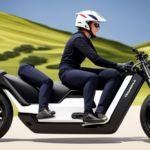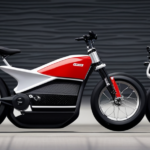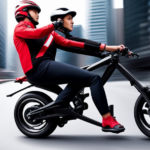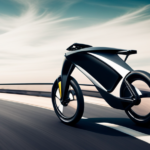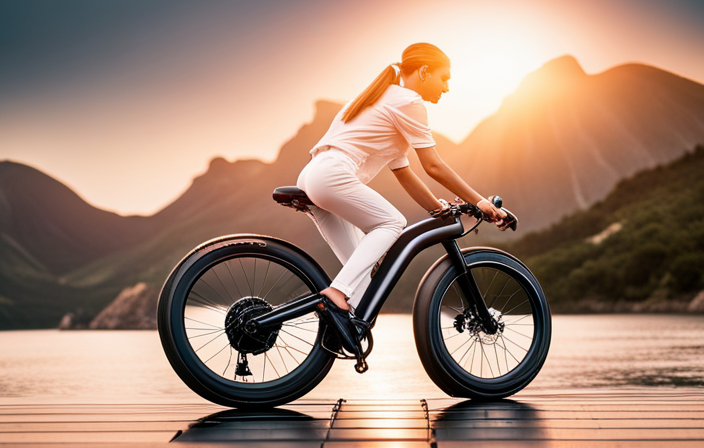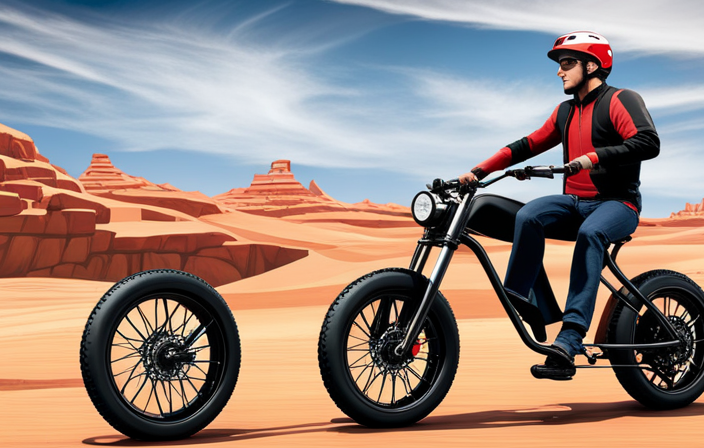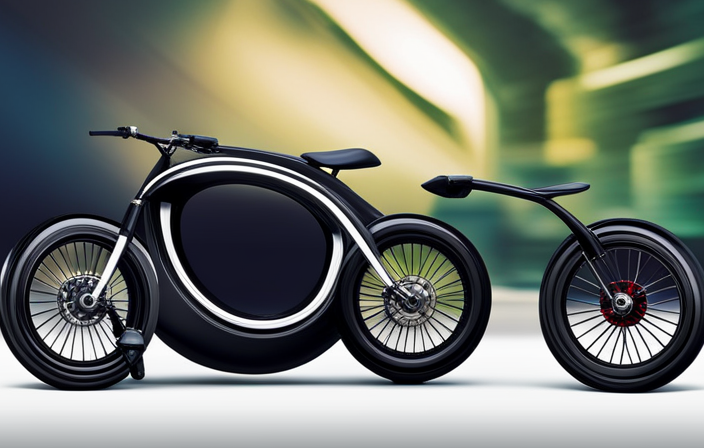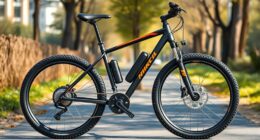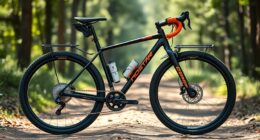Picture yourself cruising down the open road on an electric bike, the wind in your hair and the thrill of adventure at your fingertips.
But before you embark on this electrifying journey, you may be wondering just how far these innovative machines can take you.
In this article, we will delve into the intricacies of electric bike range, exploring factors such as battery capacity, terrain, and rider weight that can impact how far your e-bike will go.
Get ready to unlock the secrets behind the distance traveled on these modern marvels of transportation.
Key Takeaways
- Gradually increase speed and maintain a consistent speed to maximize efficiency and minimize energy consumption.
- Factors such as speed, weight, and terrain greatly impact the range of an electric bike.
- Range extenders, extra batteries, and efficient charging techniques can significantly boost an e-bike’s range.
- Regular maintenance, proper charging, and storage conditions are essential for maximizing the range and lifespan of the battery.
Understanding Electric Bike Range
How far will your electric bike go on a single charge? This is a common question among electric bike riders, and it all depends on the battery life and range of your bike.
Battery life refers to how long the battery can power your bike before it needs to be recharged. Range anxiety, on the other hand, is the fear of running out of battery power before reaching your destination.
To alleviate range anxiety, it’s important to understand the range of your electric bike. The range is influenced by various factors such as the battery capacity, terrain, rider weight, and speed. By considering these factors, you can estimate how far your electric bike will go on a single charge.
Transitioning to the next section about battery capacity and range, it’s important to understand the relationship between the two.
Battery Capacity and Range
You can determine the battery capacity and range of an e-bike by looking at the specifications provided by the manufacturer. The battery capacity is usually measured in watt-hours (Wh) and indicates how much energy the battery can store. The range, on the other hand, refers to how far the e-bike can travel on a single charge. It is influenced by various factors such as the battery capacity, the level of assistance used, the weight of the rider, and the terrain. To give you a better idea, here is a table showcasing the battery capacity and range of three popular electric bike models:
| Electric Bike Model | Battery Capacity (Wh) | Range (Miles) |
|---|---|---|
| Model A | 400 | 30 |
| Model B | 500 | 40 |
| Model C | 600 | 50 |
Understanding battery life and range anxiety is crucial for e-bike riders. However, it’s also important to consider the impact of terrain on range, which I will discuss in the next section.
The Impact of Terrain on Range
The terrain can significantly affect the range of an e-bike. When riding on hilly or mountainous areas, the impact of elevation becomes evident. As the bike climbs uphill, it requires more power from the battery, reducing the overall range. On the other hand, when riding downhill, the e-bike can regenerate some energy through regenerative braking, extending the range.
Another factor to consider is the effect of wind. Riding against a strong headwind can increase resistance and decrease the range of the e-bike. Conversely, riding with a tailwind can provide a slight boost and improve the range.
In summary, the impact of elevation and wind on the range of an e-bike should not be underestimated. Understanding these factors can help riders plan their routes and manage their battery usage more efficiently.
Transitioning into the subsequent section about ‘pedal assist vs. throttle-only range,’ it is important to consider how these factors can vary depending on the mode of assistance used.
Pedal Assist vs. Throttle-only Range
When using pedal assist or throttle-only mode, it’s important to consider the impact on the range of your e-bike. The range comparison between these two modes can vary depending on several factors, including battery technology.
| Mode | Range (miles) |
|---|---|
| Pedal Assist Level 1 | 40 |
| Pedal Assist Level 3 | 30 |
| Throttle-only | 20 |
As you can see from the table above, using pedal assist generally allows for a greater range compared to throttle-only mode. This is because pedal assist utilizes the rider’s pedaling power in addition to the motor, making the battery last longer. On the other hand, throttle-only mode relies solely on the motor, resulting in a shorter range.
Considering these range differences, it’s important to choose the mode that suits your needs and preferences. Now, let’s explore another important factor that affects the range of an electric bike: rider weight.
Rider Weight and Range
To maximize your e-bike’s range, consider how your weight affects it. The rider weight impact plays a significant role in determining how far your electric bike can go on a single charge. Here are four key points to keep in mind:
-
Weight distribution: A heavier rider will put more strain on the motor, resulting in reduced battery life. It’s important to distribute your weight evenly and avoid excessive leaning or sudden movements.
-
Battery capacity: Battery technology advancements have led to more efficient and longer-lasting batteries. However, heavier riders may still experience a decrease in range compared to lighter riders due to the additional power required to propel the bike.
-
Terrain: Uphill climbs and rough terrains will require more power from the motor, impacting your e-bike’s range. Heavier riders may notice a more significant decrease in range under these conditions.
-
Pedal assist vs. throttle-only: Opting for pedal assist can help conserve battery power by utilizing your own pedaling strength. Throttle-only mode, on the other hand, relies solely on the motor, which may result in reduced range for heavier riders.
Considering these factors, it’s important to understand how rider weight impacts the range of an electric bike.
Moving on to weather conditions and range, it’s essential to take into account how different weather elements can affect your e-bike’s performance.
Weather Conditions and Range
Consider how different weather conditions can affect the range of your e-bike. Weather impact plays a significant role in determining how far your electric bike can go on a single charge. Factors such as wind speed, temperature, and precipitation can all influence the efficiency of your e-bike’s battery. To illustrate the impact of weather conditions on range, let’s compare two hypothetical scenarios in a table:
| Weather Conditions | Range (Miles) |
|---|---|
| Sunny and calm | 40 |
| Windy and rainy | 30 |
As you can see, adverse weather conditions can reduce the range of your e-bike. Windy and rainy conditions decrease aerodynamic efficiency and cause increased resistance, resulting in a shorter range. It’s important to consider these factors when planning your e-bike rides. Now, let’s explore the role of tire pressure in range, which is another crucial aspect to consider.
The Role of Tire Pressure in Range
Tire pressure plays a significant role in determining the range of your e-bike. Proper tire pressure maintenance is crucial to ensure optimal performance and efficiency.
When the tire pressure is too low, it creates more rolling resistance, making it harder for the motor to propel the bike forward. This results in a decrease in range as the battery drains faster.
On the other hand, overinflated tires can cause a harsh ride and reduce traction, affecting the bike’s handling and safety. It is important to follow the manufacturer’s tire pressure recommendations, which are often imprinted on the side of the tire.
By maintaining the correct tire pressure, you can maximize the range of your electric bike and enjoy a smoother, more efficient ride.
Now let’s explore some efficiency tips for maximizing range.
Efficiency Tips for Maximizing Range
Now that we understand the role of tire pressure in maximizing range, let’s dive into some efficiency tips for optimizing the range of electric bikes. By implementing these range optimization techniques, you can go even further on your electric bike adventures.
- Smooth Acceleration: Gradually increase your speed to minimize energy consumption.
- Consistent Speed: Maintain a steady pace to maximize efficiency.
- Utilize Regenerative Braking: Take advantage of regenerative braking systems to recover energy while slowing down.
- Mindful Gear Shifting: Shift gears strategically to maintain an optimal cadence and reduce unnecessary energy expenditure.
By incorporating these techniques into your riding style, you can maximize the efficiency and range of your electric bike.
But, range isn’t solely dependent on these factors. The influence of riding style on range is another important aspect to consider.
The Influence of Riding Style on Range
To maximize the range of your electric bike, it’s important to be mindful of your riding style. The way you ride can greatly influence how far your bike will go on a single charge. Two factors that have a significant impact on range are speed and weight. Riding at higher speeds consumes more battery power, reducing the overall range of the bike. It’s recommended to maintain a steady and moderate speed to maximize efficiency. Additionally, the weight you carry on your bike can also affect the range. Carrying heavy loads or accessories can increase the energy required to propel the bike, leading to a decrease in range. By being conscious of your riding style and making adjustments accordingly, you can ensure that your electric bike will go the distance. Now, let’s explore range extenders and extra batteries to further extend your bike’s range.
Range Extenders and Extra Batteries
If you want to increase the distance you can travel on your e-bike, consider using range extenders or adding extra batteries.
There are several range extender options available in the market that can significantly boost your e-bike’s range. These range extenders are typically small and lightweight, making them easy to attach to your bike. They work by providing additional power to your e-bike’s existing battery, allowing you to go further without worrying about running out of juice.
Another option is to add extra batteries to your e-bike setup. This means carrying additional batteries with you and swapping them out when needed.
To maximize the range of your e-bike, it’s also important to adopt efficient battery charging techniques. Charging your battery fully and avoiding frequent partial charges can help extend its overall lifespan and range.
With the right range extender options and battery charging techniques, you can significantly increase the distance you can travel on your e-bike.
Now, let’s delve into the next section about charging options and range.
Charging Options and Range
When it comes to charging options and range, you have several choices to consider.
First, you can charge your electric bike using a standard wall outlet, which is the most convenient option for many riders. However, keep in mind that the charging time can vary depending on the battery capacity.
If you’re looking for a faster charging option, you can invest in a Level 2 charger, which can significantly reduce charging time.
Another option to extend your range is to carry an extra battery with you. This allows you to swap out batteries when one runs out, eliminating range anxiety and keeping you on the road longer.
So, with these charging options, you can maximize your electric bike’s range and minimize any worries about running out of power.
Now, let’s discuss the importance of regular maintenance for range.
The Importance of Regular Maintenance for Range
Regular maintenance is essential for maximizing the range of your electric bike. Battery maintenance plays a crucial role in ensuring optimal performance and range. To keep your battery in top condition, it is important to follow a few key steps.
First, make sure to charge your battery regularly and avoid letting it fully discharge. This helps prevent capacity loss and extends the overall lifespan of your battery.
Additionally, keep your battery clean and dry, as moisture can damage the cells. It is also recommended to store your battery in a cool and dry place when not in use.
By following these maintenance practices, you can optimize the range of your electric bike and enjoy longer rides.
Now, let’s explore some real-life range examples and comparisons to further understand the capabilities of electric bikes.
Real-Life Range Examples and Comparisons
To better understand the capabilities of e-bikes, let’s explore some real-life examples and comparisons of range.
Battery technology has come a long way, allowing electric bikes to travel impressive distances on a single charge. For instance, a high-quality e-bike with a 500Wh battery can provide a range of around 50-70 miles, depending on factors such as terrain, rider weight, and pedal assist level.
On the other hand, some e-bikes equipped with larger capacity batteries, like 750Wh or 1000Wh, can offer ranges of up to 100 miles or more. It’s important to note that range anxiety, the fear of running out of battery, can be alleviated by planning ahead and knowing your bike’s capabilities.
Understanding the range potential of different e-bike models can help riders make informed decisions.
Moving on to factors that can decrease electric bike range…
Factors That Can Decrease Electric Bike Range
One way you can decrease your e-bike range is by riding on hilly terrain. The constant uphill climbs require more power from the motor and drain the battery faster. Another factor that can decrease electric bike range is the battery lifespan. Over time, the battery’s capacity to hold a charge diminishes, reducing the overall range. Additionally, the impact of accessories on the bike can also affect the range. Accessories such as lights, racks, and fenders add weight to the bike, which increases the energy required to propel it and decreases the range. In order to make an informed decision about the right electric bike range for you, it is important to consider these factors and how they may impact your riding experience. This will be further discussed in the subsequent section.
Conclusion: Deciding the Right Electric Bike Range for You
When deciding the right range for you, consider your riding needs and the factors discussed earlier. Electric bike range factors, such as battery capacity and motor efficiency, play a crucial role in determining how far your bike can go on a single charge. Range considerations for different riders vary based on their preferences and usage. Here are three important things to keep in mind:
-
Terrain: Riding on hilly or uneven terrain can decrease your electric bike’s range as the motor has to work harder to overcome the resistance. Consider the type of terrain you’ll be riding on regularly.
-
Speed: Riding at higher speeds consumes more battery power, reducing your range. If you prefer faster rides, you may need to choose an electric bike with a larger battery capacity.
-
Payload: Carrying heavy loads, such as groceries or backpacks, can also impact your electric bike’s range. Keep in mind the weight you’ll be carrying and factor it into your range calculations.
By considering these factors, you can make an informed decision and choose the right electric bike range that suits your needs.
Frequently Asked Questions
Can using pedal assist mode extend the range of an electric bike?
Yes, the terrain can affect the effectiveness of pedal assist mode on an electric bike. Uphill climbs may require more power, while flat surfaces may allow for more efficient use. There is no specific speed at which pedal assist mode becomes less efficient.
How does rider weight affect the range of an electric bike?
Rider weight affects the range of an electric bike. Heavier riders may experience a slight decrease in range compared to lighter riders. However, using pedal assist benefits and the impact of terrain on range are more significant factors to consider.
What are some efficiency tips for maximizing the range of an electric bike?
To maximize your electric bike’s range, follow these efficiency tips: keep your tires properly inflated, pedal lightly, avoid excessive weight, and maintain regular upkeep. These practices are essential for increasing battery life and ensuring optimal performance.
Can the range of an electric bike be extended with range extenders or extra batteries?
Yes, the range of an electric bike can be extended with range extenders. These devices provide additional power to the battery, increasing the distance that can be traveled. However, using extra batteries has its own pros and cons.
How do weather conditions affect the range of an electric bike?
In my experience, temperature can have a significant impact on the range of an electric bike. For every 10 degrees Celsius drop in temperature, the range may decrease by about 10%. Riding on hilly terrain can also reduce the range due to increased energy consumption.
Conclusion
After delving into the intricacies of electric bike range, it is clear that the possibilities are boundless. The battery capacity and terrain play a vital role in determining how far you can go, while pedal assist or throttle-only options offer different ranges.
Rider weight and regular maintenance also come into play, ensuring optimal performance. Real-life examples have shown the varying ranges among electric bikes. However, factors like weather conditions and accessories can decrease range.
So, when choosing the right electric bike range, consider all these factors and embark on a journey that knows no limits.


